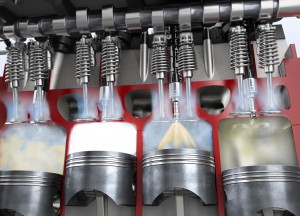Bosch, with its common-rail technology, has revolutionised one type of internal-combustion engine by means of direct injection. In the space of a decade, this technology became the undisputed standard for diesel engines. Today, it features in some 80 percent of new diesel vehicles worldwide. A similar transformation is currently taking place in connection with the downsizing trend for the gasoline engine.
 With its gasoline direct injection, drivers benefit from higher torque at low speeds and therefore enhanced driving enjoyment. At the same time, the system reduces fuel consumption by up to 15 percent. “Gasoline direct injection is now heralding the same kind of revolution that we previously saw in diesel engines,” says Rolf Bulander, the Member of the Board of Management of Robert Bosch GmbH responsible for powertrain technology. In Europe, the technology is already on the way to becoming standard, and Bosch components can be found in sporty compact cars, touring sedans, SUVs, and sports cars.
With its gasoline direct injection, drivers benefit from higher torque at low speeds and therefore enhanced driving enjoyment. At the same time, the system reduces fuel consumption by up to 15 percent. “Gasoline direct injection is now heralding the same kind of revolution that we previously saw in diesel engines,” says Rolf Bulander, the Member of the Board of Management of Robert Bosch GmbH responsible for powertrain technology. In Europe, the technology is already on the way to becoming standard, and Bosch components can be found in sporty compact cars, touring sedans, SUVs, and sports cars.
 Starting in 1951, Gutbrod was the first automaker to use Bosch gasoline direct injection in selected models of its superior subcompact car. From 1954, Bosch made this technology available for large-scale series production in the Mercedes-Benz SL 300 -Gullwing. The basic technical principle has remained the same over the years: the injectors spray the fuel straight into the combustion chamber in such a finely atomised state that it is immediately combustible. The fact that the fuel vaporises permits greater compression, because the combustion chamber is additionally cooled. Although the new combustion method saved a lot of fuel, it took a long time before the technology gained widespread acceptance. Over decades, the company further developed gasoline direct injection with innovations such as laser drilling for the injection holes, which enables particularly exact mixture formation and clean combustion. This innovation earned Bosch, Trumpf, and the University of Jena the German Future Prize in 2013.
Starting in 1951, Gutbrod was the first automaker to use Bosch gasoline direct injection in selected models of its superior subcompact car. From 1954, Bosch made this technology available for large-scale series production in the Mercedes-Benz SL 300 -Gullwing. The basic technical principle has remained the same over the years: the injectors spray the fuel straight into the combustion chamber in such a finely atomised state that it is immediately combustible. The fact that the fuel vaporises permits greater compression, because the combustion chamber is additionally cooled. Although the new combustion method saved a lot of fuel, it took a long time before the technology gained widespread acceptance. Over decades, the company further developed gasoline direct injection with innovations such as laser drilling for the injection holes, which enables particularly exact mixture formation and clean combustion. This innovation earned Bosch, Trumpf, and the University of Jena the German Future Prize in 2013.
At the start of the new millennium, tough emissions standards in Europe brought gasoline direct injection to the mass market. This pattern is repeating itself, because vehicles will be allowed to emit on average only 95 grams of CO2 per kilometer by 2021. As a result, approximately half of new European vehicles with gasoline engines will have direct injection by as soon as 2016. “We are currently doing excellent business in Europe with gasoline direct injection. But in a few years, there will be lots of action in the U.S. and China too,” Bulander says. In these markets, the innovative injection systems are still largely restricted to imported vehicles. However, with automakers in China and the US facing tough new emissions legislation in the future, they will increasingly adopt the new technology.











Leave a Reply